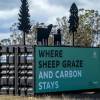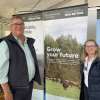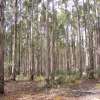
'It can go on forever': A glimpse into Tasmania's private forestry industry
Posted 22 May 2025
Managing trees Harvesting and selling wood Economic benefits and markets Native regrowth forest management PFT Tree Alliance
By Saree Satler, The Examiner
Tasmanians hear the word state forestry regularly, but what about private forestry?
For more than 35 years, private forester John Lord has been selectively harvesting the multi-aged native forest on his family's 750-hectare property in Bracknell.
But what does "selectively harvest" mean?
Mr Lord said it involved removing certain trees - often the least healthy ones - to "thin" a forest, which allowed more sunlight to reach the forest floor, mitigated the risk of catastrophic fire, and created a regenerative forest.
This practice vastly differs from clear-fall logging, where all the trees are removed from an area.
Selective harvesting dates back thousands of years, with Aboriginal tribes regularly burning off areas of a forest to sustainably manage the land they lived on.
The forests regrew, and the cycle continued.
With two-thirds of the land made up of Eucalyptus trees and one-third plantation, contractors on the Lords' land very carefully "mimic" this Indigenous method, using machinery rather than fire.
"It can go on forever. Native forests don't require any chemicals at all - it is truly circular", Mr Lord said.

Conservationist versus protectionist
Mr Lord said, unlike many other places in the world, Tasmanian native forests have adapted to active management and require it to thrive.
"Conservationists actively manage forests to keep them healthy and safe," he said.
"Protectionists lock the gate - but Tasmanian forests and grasslands were managed by Aboriginals for 50,000 years, they adapted to this, so if you don't keep doing it, they become unhealthy and the biomass accumulates, which is very dangerous."
Hear from a fire expert
Professor of Pyrogeography and Fire Science David Bowman said dense native forests posed a "significant risk".
He said old growth shouldn't be logged because there isn't enough of it, but clear-felling wasn't the answer either. Instead, the future of forestry relied on managing regenerative forests.
"I will tell anyone who will listen that the future of forest management in Tasmania is reducing the density of the regrowth," Professor Bowman said.
All-or-nothing thinking
Professor Bowman said the forestry debate has become far too "black and white", and if the industry wanted to regain its social license, it required working with the community and being attentive.
"Sustainable Timbers is a work in progress - I know they are trying to innovate," he said.
"[It should be] trialling different sorts of innovative forestry and getting feedback from the community to build the social license."
The professor said "real action" was not black and white, but in the middle, which was learning how to manage regenerative forests.
"We are still learning about the middle, it's about building a social license and the science," he said.
"A forest industry in Tasmania is a good thing, we have a fantastic resource that we can use, but it's got to be done sustainably."
Mr Lord said there was a lack of understanding in the community about what he does, but after more than 35 years of watching something work, he wanted to educate others.
"These are facts, it's not an ideology - we are conservationists, we do a lot of work, it's constant, it will go on forever," he said.
"We've been very happy to show people what we do, and we are open to comments and all sorts of questions."
Sustainable Timber Tasmania
General Manager Conservation and Land Management for Sustainable Timber Tasmania Suzette Weeding said when STT harvest or partially harvest an area, that area is regenerated or re-established so the forest can regrow.
"STT is responsible for the management of 821,000 hectares of Permanent Timber Production Zone land, which includes land available for wood production, as well as land managed for reservation," Ms Weeding said.
In 2023-24, 5855 hectares of forest on Permanent Timber Production Zone land were harvested for forest products.
Ms Weeding said the area constituted less than one per cent of the land STT manages.
"Of the forest harvested, 70 per cent was undertaken using partial/selective harvesting methods," she said.
Ms Weeding said STT engaged extensively with the community and stakeholders through a variety of communication touchpoints, including the Three-Year Wood Production Plan.
"Each year, STT releases an update to its Three-Year Wood Production Plan to the Tasmanian community for feedback," she said.
SST also offers registered stakeholders information about annual programs, Forest Practices Plans and intended commencement of planning, harvesting and burning.






